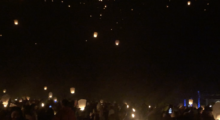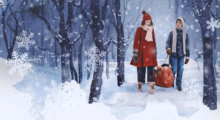
Before reading Kamla K. Kapur’s book, “Rumi: Tales of the Spirit, A Journey to Healing the Heart,” I had only been familiar with Rumi’s poems, and for good reason. Rumi (1207-1273) is best known for his work as a 13th-century Persian poet, but, unsurprisingly, it turns out he’s also a wonderful storyteller. Here Kamla K. Kapur presents us with 12 of his stories from his six-volume “Mathnawi.” The book is broken into 3 sections: the first, Embrace Suffering, the second, Pray, and the third, Surrender to the Cosmic Wheel.
While all the stories are unique, they contain a similar theme, which is that all the main characters suffer in one way or another. And with this suffering, comes the lessons they need to learn to persevere through the trials of life, recognize their inner demons, and find joy and peace along the way. As the book’s subtitle says — it is a journey to healing the heart.
Following each story is Kapur’s commentary, and it’s obvious that she’s not only a scholar of Rumi’s work, but someone who loves his messages deeply. Her analysis of characters and explanation of symbols make her a fantastic guide, and I found her commentary inspiring, informative and helpful. The stories and messages of ancient mystics can sometimes be opaque or hard to understand, but the stories contained within this volume are neither of those things. I’m not sure if that’s due to Rumi, Kapur’s retelling, or a combination of the two.

Regardless, the stories contained within the book are accessible, entertaining, and ring true to the soul of Rumi. They are poetic parables with a solid message behind them, one that Kapur elegantly presents in the book’s preface: “The hope of the book is that we can turn from being closed to being open, from contraction to expansion, from isolation to connection, taking the first steps toward wisdom, happiness, and joy.”
What I loved about this book is that, although Rumi was a Sufi mystic and Islamic scholar, the stories and messages are not just for those who subscribe to a single religion (or any religion at all). In fact, there are themes that Judeo-Christian-Islamic traditions will all recognize.
But again, you do not have to subscribe to any particular religion to enjoy or benefit from this book. I would say it would serve the reader more if they were open to the idea of cultivating their consciousness, observing their thoughts, and using suffering to fuel their personal growth. This idea of spiritual or personal evolution is central in almost all religions, known most commonly as “The Way.”
As Kapur explains it, “The Way” isn’t a singular path in. Instead, it “is a method of thinking about distress that opens up doors and windows in our brain with a vision of the free blue sky beyond the dungeons we inhabit, and must inhabit, because it is our destiny to suffer. Rumi’s stories show us in unmistakable and clear signposts the obstacles to ‘The Way’ and how to overcome them.”
With that, one could consider this book a guidebook for navigating the difficulties of life. No matter what you believe, if you are someone who seeks to better understand themselves, their experiences, and their reactions to the world, you can benefit from the stories and lessons in this encouraging and inspirational book.

 “Rumi: Tales of The Spirit, A Journey to Healing the Heart” by Kamla K. Kapur
“Rumi: Tales of The Spirit, A Journey to Healing the Heart” by Kamla K. Kapur


 Sky Lanterns Bear Wishes and Remembrance into Night Sky
Sky Lanterns Bear Wishes and Remembrance into Night Sky
















